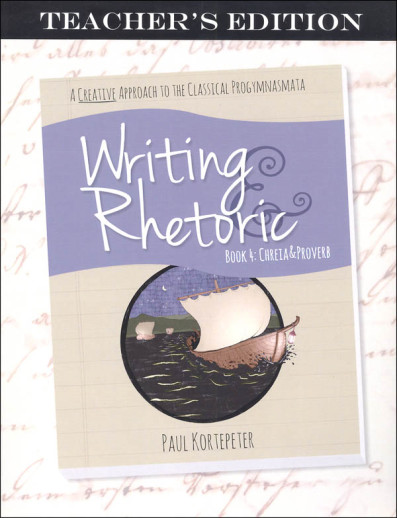We use cookies to make your experience better. To comply with the new e-Privacy directive, we need to ask for your consent to set the cookies. Learn more.
Writing & Rhetoric Book 4: Chreia & Proverb Teacher's Edition
Includes 12 lessons, 9 of which are chreia (short essays or remembrance that praises the author of a saying and shows why the saying is useful) based on sayings (proverbs) from historical figures: King Solomon, King Arthur, King Alfred the Great, King Canute, Two Medieval Poets, Francis of Assisi, Queen Elizabeth I, Lady Godiva, and King Richard III plus 3 introductory lessons detailing the process of writing a chreia. Utilizes skills learned in previous books and teaches the six-paragraph essay.
A Creative Approach to the Classical Progymnasmata. Think of the progymnasmata as a step-by-step apprenticeship in the art of writing and rhetoric. What is an apprentice? It is a young person who is learning a skill from a master teacher. Our students will serve as apprentices to the great writers and great stories of history.
Students are often expected to write with no clear model before them. Modern composition scolds traditional writing instruction as rote and unimaginative. It takes imitation to task for a lack of freedom and personal expression. And yet, effective communication from writer to reader always requires some sort of form and structure. Many of history's greatest writers learned by imitation. In other words, writing takes the same kind of determined study as ballet or diving. Creativity uses conventional form as a stage or a springboard from which to launch grand jets and somersaults. Too often students are expected to tackle complex writing assignments without learning the necessary intermediate steps. The assumption is that because most everyone can speak English well enough to be understood, and form letters with a pencil, that everyone should be able to write well. Yet how many of us would expect a child to sit at a piano, without piano lessons, and play a concerto? Writing is never automatic.
The Writing & Rhetoric series method employs fluent reading, careful listening, models for imitation, and progressive steps. It assumes that students learn best by reading excellent, whole-story examples of literature and by growing their skills through imitation. Each exercise is intended to impart a skill (or tool) that can be employed in all kinds of writing and speaking. The exercises are arranged from simple to more complex. What's more, the exercises are cumulative, meaning that later exercises incorporate the skills acquired in preceding exercises. This series is a step-by-step apprenticeship in the art of writing and rhetoric.
The word chreia (cray-ă) comes from the Greek word chreiodes (cray-o-dees), which means "useful. It is a short essay or remembrance that praises the author of a saying or proverb and shows why the saying is useful. This book employs all the skills of the preceding books in the series and teaches students how to write a six-paragraph essay on the basis of a saying or an action. The thinking and exercises occur within the framework of the stories which, in this book, include wonderful historical figures such as King Arthur, King Alfred, Lady Godiva, King Canute, Omar Khayyam, and more.
The six-paragraph essay using the five Ws (who, what, when, where, why) is arranged this way:
- Praise the person or saying of your chreia or proverb
- Restate the saying in your own words
- Explain why this is useful
- Contrast your example with another person in history
- Compare your example with another similar example in history
- Epilogue concludes your essay
Includes 12 lessons, 9 of which are chreia (short essays or remembrance that praises the author of a saying and shows why the saying is useful) based on sayings (proverbs) from historical figures: King Solomon, King Arthur, King Alfred the Great, King Canute, Two Medieval Poets, Francis of Assisi, Queen Elizabeth I, Lady Godiva, and King Richard III plus 3 introductory lessons detailing the process of writing a chreia. Utilizes skills learned in previous books and teaches the six-paragraph essay.
| Product Format: | Paperback |
|---|---|
| Grades: | 4-5 |
| Brand: | Classical Academic Press |
| Author: | Paul Kortepeter |
| ISBN: | 9781600512438 |
| Length in Inches: | 11 |
| Width in Inches: | 8.5 |
| Height in Inches: | 0.5 |
| Weight in Pounds: | 1.5 |
Be the first to review this item


I LOVED the Writing and Rhetoric Books 1 &2. I do recommend the Teacher's guide.
Need the next book in the series. We love this program!
We loved Writing and Rhtetoric Book 3 and are moving on to the next book!
I love Writing & Rhetoric. These books combine the best approaches to Language Arts. My son went from being a reluctant writer to one who writes for fun.